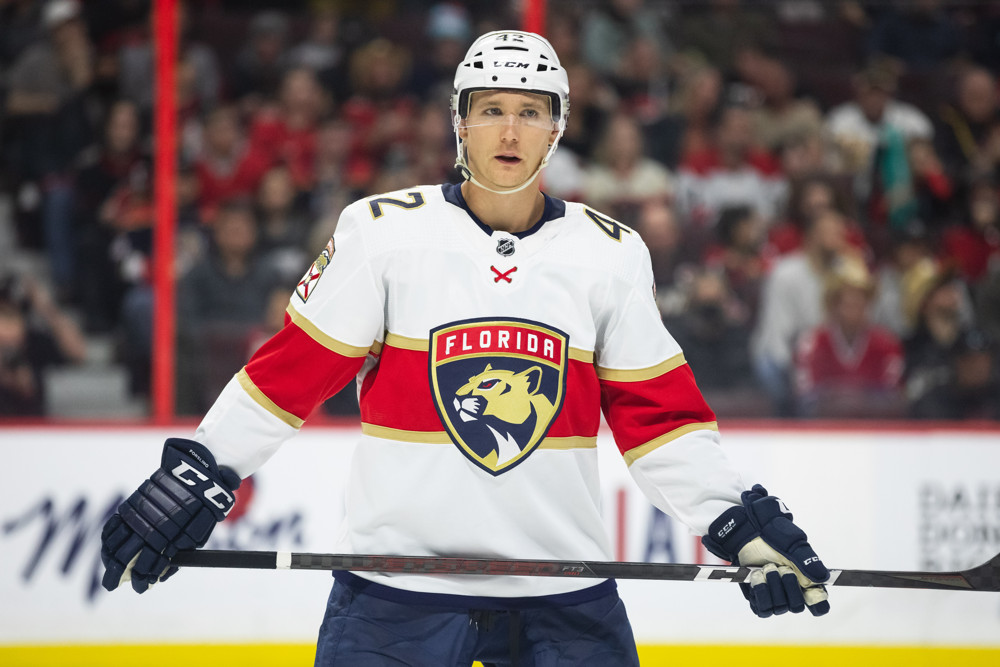Why Gustav Forsling Was the Panthers’ Unsung Hero in Round 1
The Florida Panthers were out of sorts for most of their first-round series against the Washington Capitals. Sure, they prevailed 4-2 in the end, but this matchup was a slog for the top seed in the East. Aleksander Barkov, Jonathan Huberdeau, Aaron Ekblad and MacKenzie Weegar offered hit-or-miss performances. Trade deadline acquisition Ben Chiarot has flopped so far. Sergei Bobrovsky was mediocre between the pipes. The power play, which ranked fifth in the regular season, failed to produce a single goal over the course of the series. When Washington pulled ahead 2-1, it felt like an upset was in the cards.
Then Carter Verhaeghe happened. The 26-year-old forward strapped the Panthers on his back and powered them past the Capitals by registering five goals and nine points in Games 4 through 6. He was without question Florida’s most important player down the stretch.
However, another Panther also deserves kudos for the team’s victory. Though Gustav Forsling committed an untimely penalty on Friday night, he was otherwise the club’s most reliable defenseman by a comfortable margin in Round 1. His steady and stingy displays became so apparent that his ice time spiked and he was asked to insulate Weegar. He delivered the goods, holding down the fort until Verhaege’s heroics took center stage.
Above all else, Forsling’s impact is rooted in his mobility:
The 25-year-old is quietly one of the best skaters on any blue line. His style isn’t flashy, but it’s fluid. This allows him to push up and disrupt puck-carriers in the neutral zone or sprint back to patch up any holes in the Panthers’ defensive posture. No matter how he deploys his wheels, it’s effortless.
Combine that pace with an active stick and sharp hockey sense, and you’ve got yourself a play-killer in the best sense of the term. He’s just continually in the opposition’s hip pocket, cutting down its time and space so that there’s nowhere for the puck to go but back into Florida’s hands. He doesn’t quite compare to his countryman, but there’s a Jonas Brodin-like quality to his game. He leverages his speed to keep the play in front of him and frustrate opponents. He’s always in control.
That’s translated to excellent underlying numbers. Among the 69 blueliners who have logged at least 75 minutes at 5-on-5 in the playoffs, Forsling has conceded the fewest shot attempts, fifth-fewest scoring chances, third-fewest high-danger attempts and sixth-fewest expected goals. Bear in mind that he plays on a freewheeling Panthers squad that has allowed the eighth-most expected goals among the 16 postseason participants. Those are astonishing results.
Naturally, in a chaotic sport that only gets crazier in the springtime, Forsling can’t maintain a firm handle on proceedings at all times. In these frenetic moments, he still finds ways to, well, get in the way:
At 6’0” and 186 pounds, he isn’t exactly built for this purpose. Nevertheless, his instincts and guts help him pull through. Whether he’s putting out his teammates’ fires or laying his body on the line to block shots, he recognizes threats early and has shown a knack for snuffing them out by any means necessary.
Since he trusts his skating, he doesn’t overcommit in puck pursuit either. He hustles just enough to hinder the puck-carrier without giving them an inside lane to exploit. Simply put, his defense is clean. Efficient. There’s very little wasted movement. He doesn’t chase for no reason or fall prey to distractions. When he needs it, he can summon the desperation to survive an onslaught as well. Consequently, like the finest defenders around, he suppresses goals in addition to chances. No blueliner gave up less than Forsling did (0.56 GA/60) in the first round of the playoffs.
The Panthers didn’t merely shell up during Forsling’s shifts, though. He demonstrates great poise in puck retrieval scenarios, sensing the pressure of the forecheck, spotting potential outlets and making the appropriate play:
Nothing fancy here. He doesn’t fire stretch passes like Victor Hedman or shake opponents to break the puck out by himself like Cale Makar. He simply relays the puck to his gifted teammates and lets them do what they do best: generate opportunities. On a club that features Huberdeau, Barkov, Verhaege, Claude Giroux, Sam Reinhart and Sam Bennett, that’s more than enough.
Forsling’s skill set limits the time Florida spends in its zone and maximizes the time it spends on the attack. During his shifts, the Panthers controlled 60.2% of the expected goals. Offer them sufficient cracks, and they’ll eventually pick apart the opposition. They did just that to the Capitals by scoring 12 goals in the final three contests.
As good as he was in the series, Forsling wasn’t central to this explosion. Even with a 37-point campaign to his name, offense isn’t his bread and butter. Nevertheless, he can contribute in that department via his judicious shot selection:
Some defensemen blast pucks the second they receive them. Others take so long to make up their mind that they regularly fire their bids right into shin pads. Forsling strikes a nice balance, waiting for traffic to develop before pulling the trigger but also ensuring that he gets his shots through. His lateral agility and feints open up ample room at the point and his bids provide his teammates with plenty of second-chance looks.
While the Panthers were slow to find their bearings, Forsling was dialed in from the jump. The goal tally during his time on ice at 5-on-5 was 11-1 in Florida’s favor. On the back of his superb defense and crafty transition game, he bought the forwards some leeway as their output transformed from occasional flurries into an avalanche that ultimately overwhelmed the Capitals.
Recent Posts

How Corey Perry Is Making His Presence Felt With the Lightning
View Post »
How Adam Fox Pushed the Rangers Past the Penguins
View Post »

